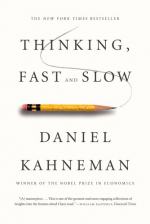
|
| Name: _________________________ | Period: ___________________ |
This quiz consists of 5 multiple choice and 5 short answer questions through Chapters 30 - 34.
Multiple Choice Questions
1. What term does the author apply to the idea that once you have accepted a theory and used it as a tool in your thinking, it is extremely difficult to notice its flaws?
(a) An anchoring effect.
(b) Theory-induced blindness.
(c) Narrative fallacy.
(d) The availability cascade.
2. What organization paid for Thaler to spend a year working with Kahneman in Vancouver?
(a) The Michael Conner Foundation.
(b) The Russell Sage Foundation.
(c) The Roosevelt Foundation.
(d) The Spencer C. Kaufman Foundation.
3. Who is the author of Clinical vs. Statistical Prediction: A Theoretical Analysis and a Review of the Evidence?
(a) Paul Meehl.
(b) Baruch Fischhoff.
(c) Malcolm Gladwell.
(d) Jerry I. Porras.
4. How is the decision contruction of narrow framing defined?
(a) A single decision with two options.
(b) A single decision with four options.
(c) Two simple decisions, considered separately.
(d) Four simple decisions, considered separately.
5. Who are the authors of Built to Last?
(a) Keith Stanovich and Richard West.
(b) Jim Collins and Jerry I. Porras.
(c) Baruch Fischhoff and Gary Klein.
(d) Christopher Chabris and Daniel Simons.
Short Answer Questions
1. What statistician illustrated the ease with which people see patterns where none exist?
2. What neighborhood within Niagara Falls, New York was the location of a 70-acre landfill that was the epicenter of a massive environmental disaster?
3. What branch of medicine deals with the incidence, distribution, and possible control of diseases and other health factors?
4. The operations of System 2 have one feature in common. What is this feature?
5. In what branch of the military did the author complete service?
|
This section contains 277 words (approx. 1 page at 300 words per page) |

|




